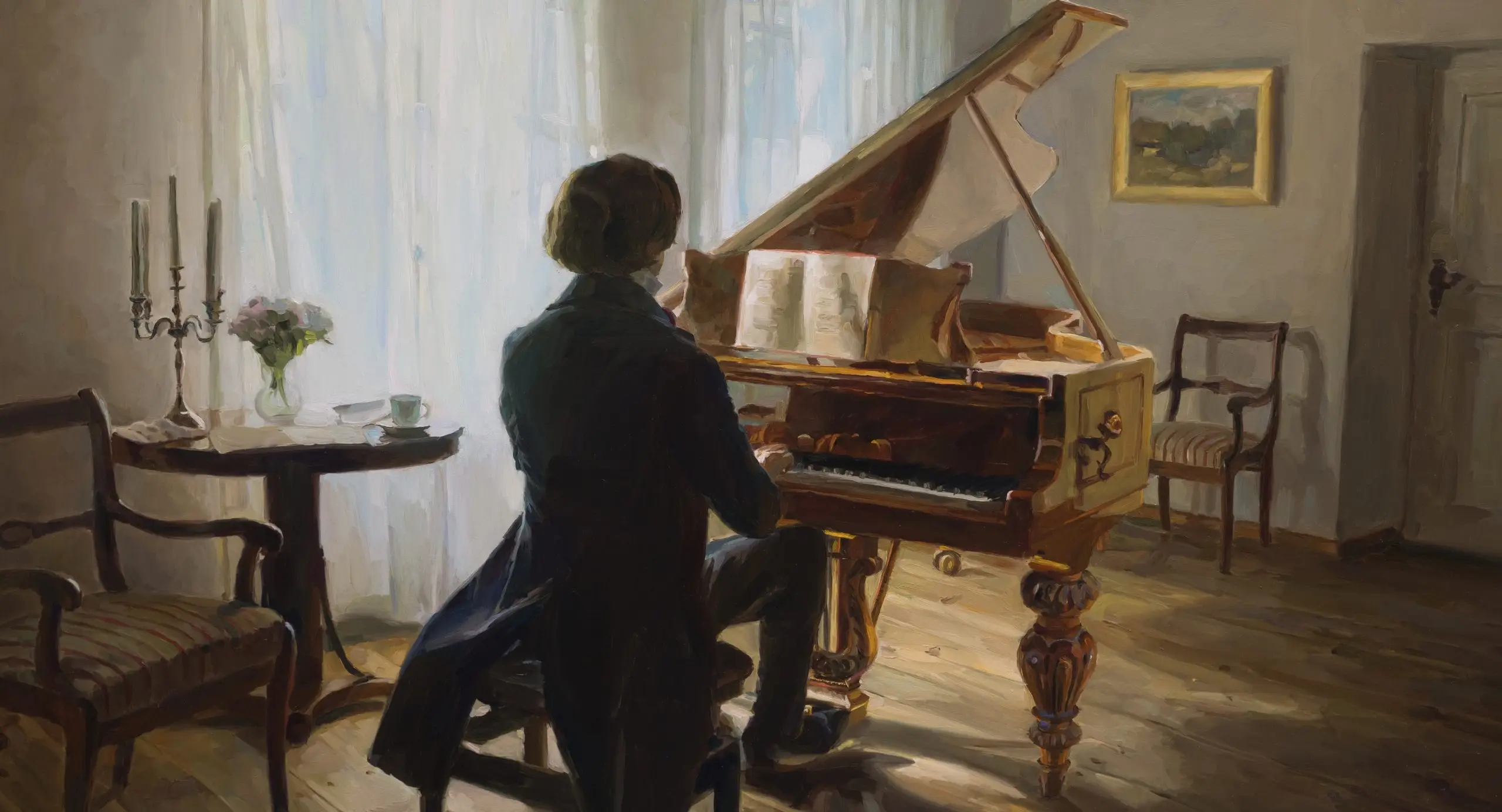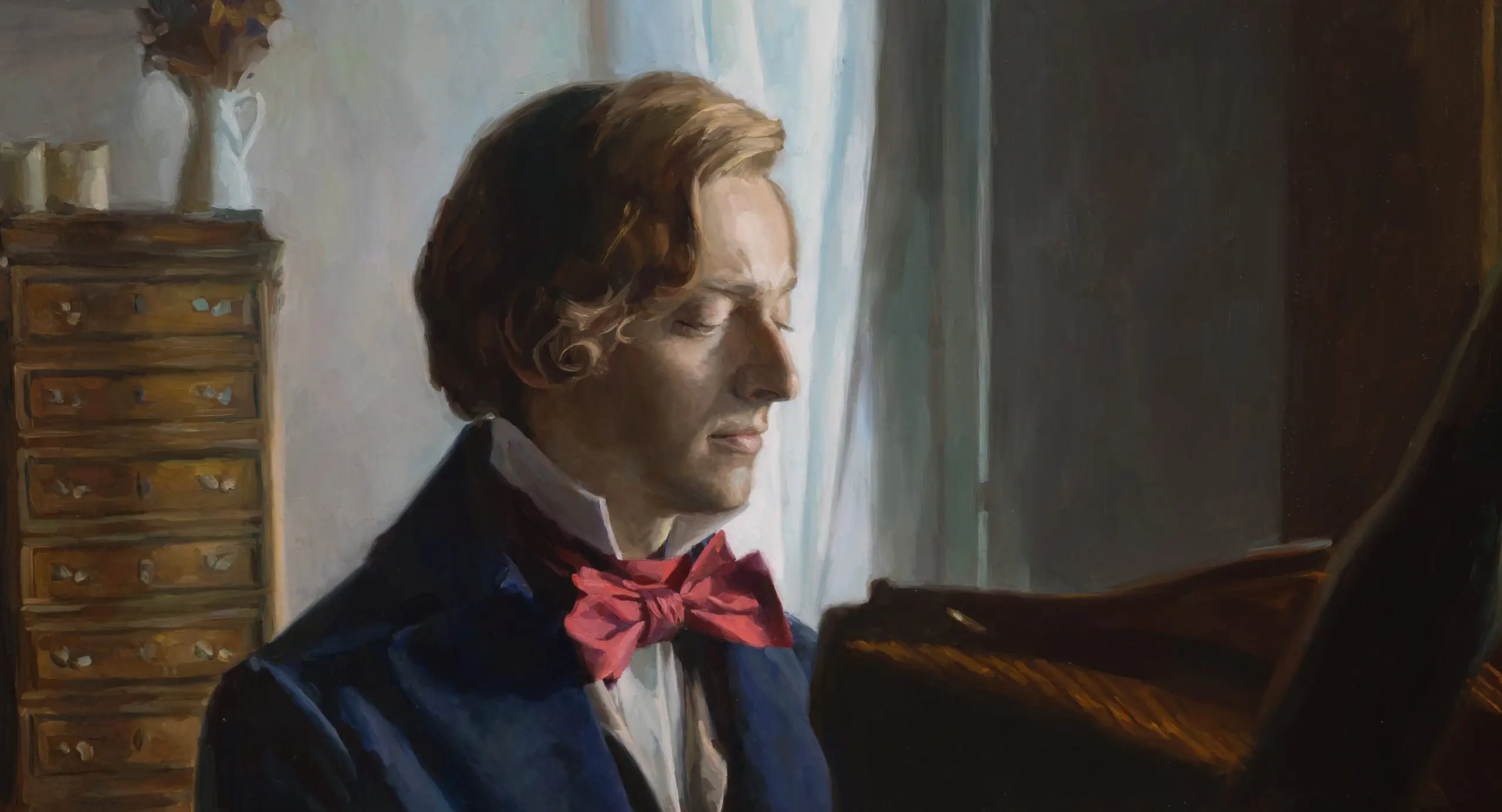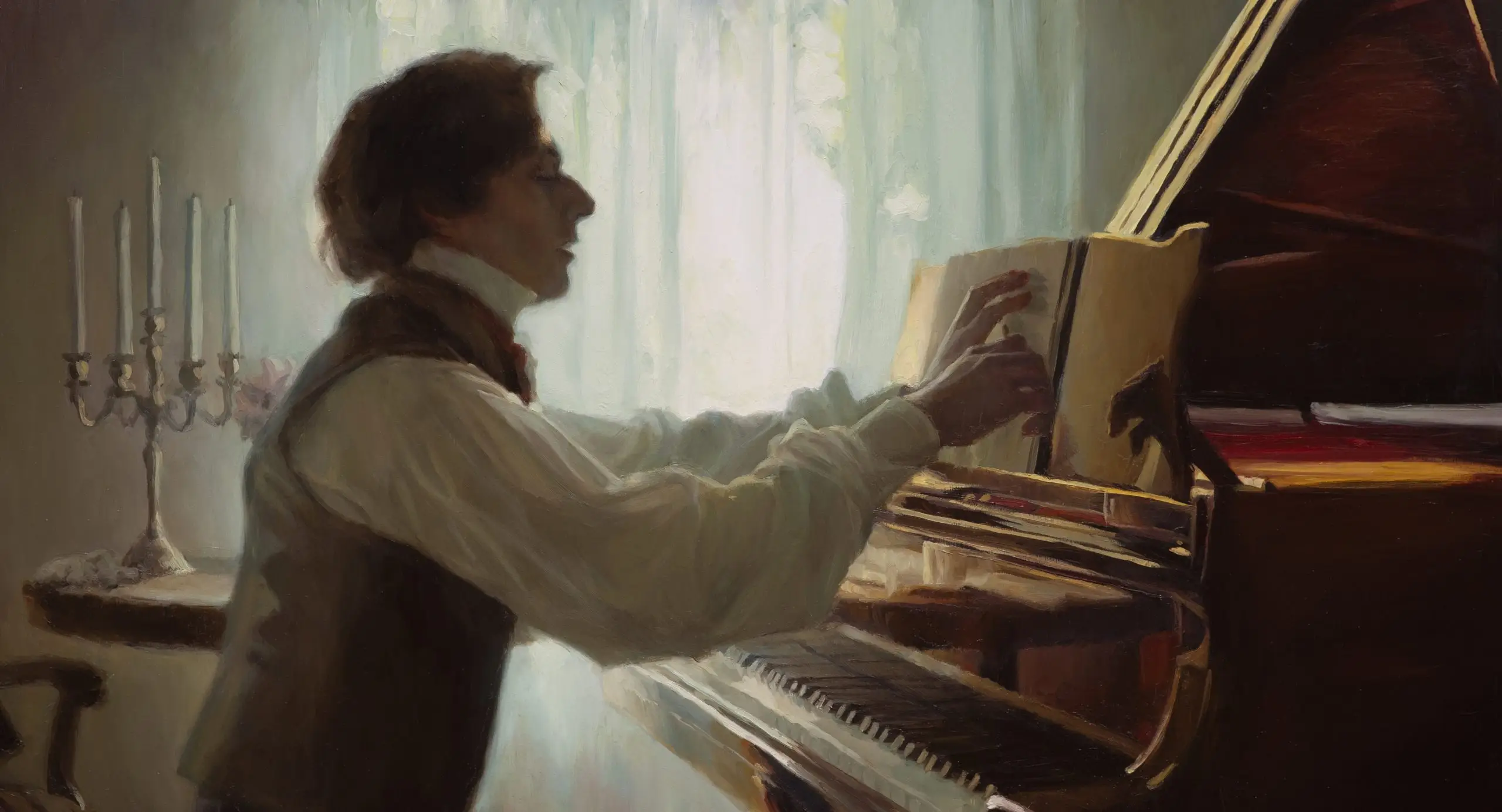“Timeless Chopin” – A behind-the-scenes look at the creation of a unique animation for the Poland Pavilion
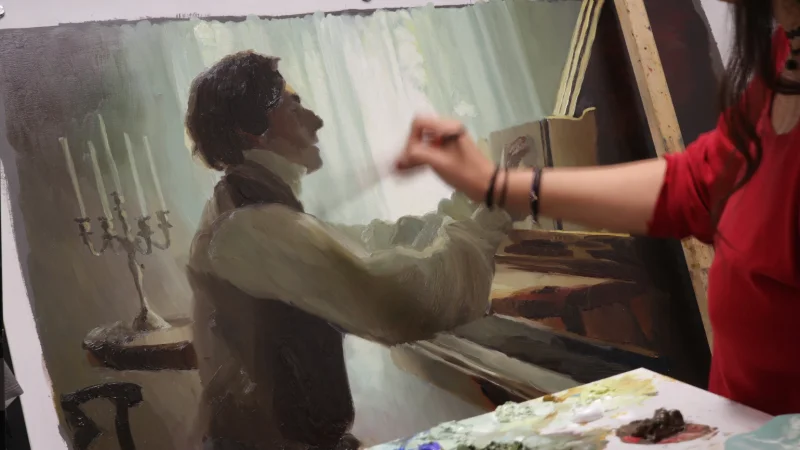
Works are currently in progress on an animation that will be presented in the Poland Pavilion at Expo 2025 Osaka, Kansai. The main character is Fryderyk Chopin, with production led by the renowned Polish studio BreakThru Films.
BreakThru Studio is in charge of the animation. Their first major production, “Peter and the Wolf”, won an Oscar for Best Animated Short Film. The studio also created the first-ever fully painted feature film, “Loving Vincent”, which received Oscar and Golden Globes nominations for Best Animated Feature. The film “Peasants”, which premiered in 2023, won the hearts of viewers not only in Poland, but also around the world.
The first stage of the animation was to record footage with the actors. Polish pianist Paweł Popko took on the role of Fryderyk Chopin. The casting team admitted that the artist “felt the music”, with his facial expressions and body movements effectively conveying the emotions desired by the creators. In the context of the resulting animation, this was more important than the acting experience. The filming took place in several locations, including Żelazowa Wola, the Birthplace House of Fryderyk Chopin. The Fryderyk Chopin Institute, which manages the facility, made the House available for organising the film set.
Painting work is currently in progress, featuring the contributions of prominent artists. Based on the recorded footage, key frames are created using oil paints. Undeniably, this is the most vibrant stage of the entire process. The materials prepared in this way will subsequently be used for animation.
The animation “Timeless Chopin” is set to be completed early next year and will premiere on 13 April 2025, coinciding with the opening of the Poland Pavilion and the start of the Expo 2025 Osaka, Kansai. It is therefore worth planning a visit to the Poland Pavilion now. In the meantime, you are welcome to learn more about the behind-the-scenes of the whole process, as told by Piotr Dominiak, animation director.
Behind the scenes of animation: the director’s perspective
What makes the technique used to create the animation unique?
It seems that what makes this technique unique is not simply the use of oil paints for animation, as painted animation has been around for quite some time. Instead, it is that our studio has developed a painterly animation process that is suitable for large-scale film production.
With the development and creation of PAWS (Painting Animation Work Station), it is possible to animate both on the basis of video footage (so-called rotoscopy) and completely freely, from the head. The animation table also enables the use of techniques such as paint on glass and various other methods that involve stop-motion animation. The standardised process for preparing materials, the animation itself, and its coordination gave us greater control, streamlined the procedure, and, most importantly, accelerated the animation process.
How many people are involved in production, what is the division of tasks and the creative process itself?
The number of people working on such production varies and depends on the stage. The live action involves around a dozen people, and we’re referring to just a one-day shoot. Any other major productions are handled by larger teams, of course. The next step is pre-production, which involves preparing the footage from the set, editing, sound editing, adding any necessary VFX, and finally, the painterly animation itself. This stage requires the collaboration of about ten animators over several months. Typically, this is when the team is at its largest.
We are currently in the pre-production process. We are preparing the final edit, in which the entire animation will be divided into individual shots. A separate “layout” will be developed for each of them, i.e. the overall look of the frame. At this stage, we begin by creating matte paintings—digital images that quite precisely define the frame’s look, light sources, colours, and overall atmosphere. Next, key frames are painted in oil based on these matte paintings. Key frames are often composed using live-action footage. Only thus prepared materials and references are handed over to the animator for the animation process.
Of course, the animation itself undergoes continuous scrutiny to ensure consistency across shots, avoiding any unwanted effects or simple errors. The processed shots are further refined and composed during post-production. Colour correction and any additional VFX treatments are applied.
What story will be presented in the animation? What is the focus of the story?
“Timeless Chopin” is a short animation lasting about a minute. Our aim was chiefly to show Chopin’s influence on the present, while also highlighting it in the context of distinctly Polish imagery.
As an artist, Chopin is inherently tied to Poland and associated with it, so we felt that a visual style referencing the finest examples of Polish painting was most appropriate. In the film, we show a bit of the artist’s creative process, his quest for perfection. Chopin’s work, as we know, has had and continues to have an enormous impact on generations of people. His music has become an integral part of the art canon. The Chopin Competition, referenced in the film, aims to demonstrate that a profound desire to create, coupled with persistence and exceptional talent, contributes to success that makes history.
What reactions do you hope the film will evoke in audiences?
Nostalgia, thrill, delight in the beauty of painting and music combined into one piece. Probably also curiosity related to technology and general interest in Polish art.
What do you make of the “gene of creativity” inherent in the DNA of Poles?
I would associate it with the resourcefulness and entrepreneurial spirit of Poles, which stems directly from our history, rich in both significant achievements and tragic events. (…) This is where I would see the extraordinary need of Poles to create, as a manifestation of a certain rebellion and the need for freedom in the broadest sense.
Meet the animation director
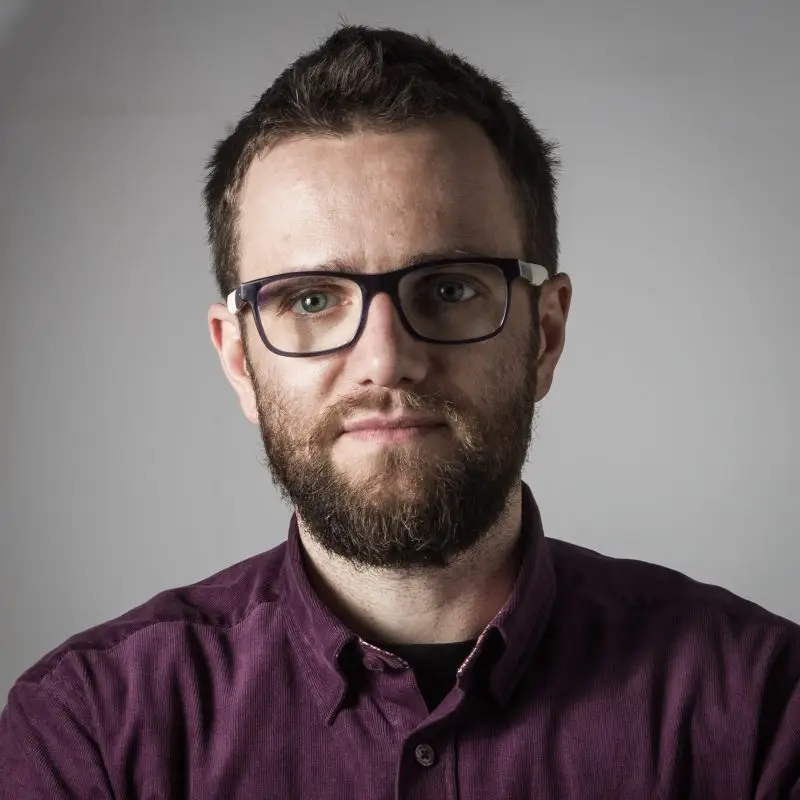
Piotr Dominiak
Piotr Dominiak graduated from the Academy of Fine Arts in Łódź with a degree in painting and graphic design. His specialises in landscape painting.
Early in his career, he engaged in various painting-related activities, including interior decoration, polychromy, custom artwork, advertising walls, and murals. He entered the film industry by working on the Oscar-winning “Peter and the Wolf”, produced by BreakThru Films. There, he was involved in production design work, painting over 1 000 square meters of forest backgrounds and moonlit nights alongside a team of several painters.
Shortly afterwards, he became the head of painterly animation on Dorota Kobiela’s short film, “Little Postman”, and later contributed as one of the painters in the research and development of “Loving Vincent”. He collaborated with them to paint-animate for the concept trailer of the world’s first full-length painterly animation. He served as the primary tutor for painters starting their training in preparation for “Loving Vincent” and later supervised 125 animators working on the film. He also painted some of the film’s most challenging shots and contributed to the production design, earning him the Eagle, the Polish Film Award, in 2017.
During the development of the film “Peasants”, he primarily served as the art director and animation director, while also acting as a secondary production designer. He was responsible for overseeing the artwork involved in creating matte paintings, keyframes, and, of course, the painterly animation itself, which was carried out in four studios by approximately 80 painters.
